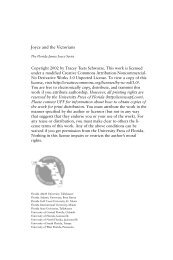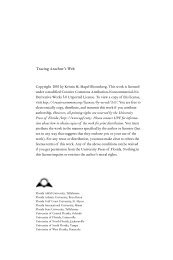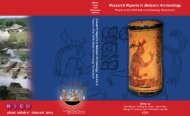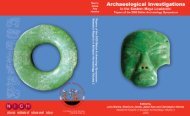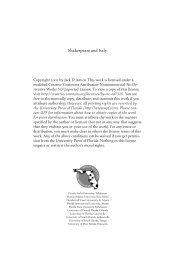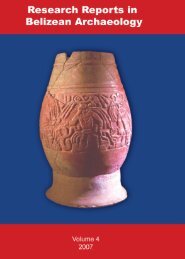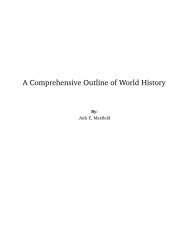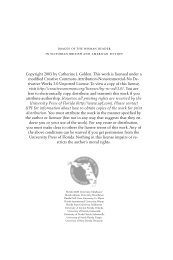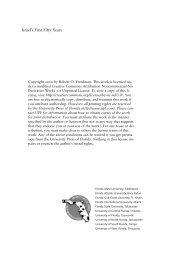Bernard Shaw's Remarkable Religion: A Faith That Fits the Facts
Bernard Shaw's Remarkable Religion: A Faith That Fits the Facts
Bernard Shaw's Remarkable Religion: A Faith That Fits the Facts
Create successful ePaper yourself
Turn your PDF publications into a flip-book with our unique Google optimized e-Paper software.
Realism 21<br />
evenhanded. Tyndall presented an imaginary debate between a disciple of<br />
Lucretius (<strong>the</strong> proponent of Matter) and <strong>the</strong> eighteenth-century <strong>the</strong>ologian<br />
and philosopher Bishop Butler (<strong>the</strong> champion of Spirit). Both, Tyndall<br />
contended, present unanswerable arguments. He particularly stressed his<br />
endorsement of <strong>the</strong> words he put into <strong>the</strong> mouth of <strong>the</strong> bishop: “You cannot<br />
satisfy <strong>the</strong> human understanding in its demand for logical continuity<br />
between molecular processes and <strong>the</strong> phenomena of consciousness. This is<br />
a rock on which Materialism must inevitably split whenever it pretends to<br />
be a complete philosophy of life” (180). For Tyndall <strong>the</strong> answer to <strong>the</strong> difficulty<br />
lay in a radical revision of our conception of matter. Matter has<br />
been unjustly maligned. We have been taught to think of spirit as <strong>the</strong><br />
epitome of goodness and matter as <strong>the</strong> essence of baseness, when we<br />
should regard <strong>the</strong>m both as “essentially mystical and transcendental”<br />
(“Vitality” 57). We should not think of “brute matter” but of “<strong>the</strong> living<br />
garment of God” (“Scientific Use of <strong>the</strong> Imagination” 141). Shaw rightly<br />
observed that Tyndall’s “materialism” reveals “a nobility which produces<br />
poetry” (Pref. Methuselah 5:317). But Shaw neglects to mention that Tyndall<br />
is candidly open to <strong>the</strong> demands of <strong>the</strong> spirit and humble in confessing<br />
his ignorance when confronting its mystery.<br />
George Eliot<br />
Regarding George Eliot as <strong>the</strong> literary exponent of <strong>the</strong> 1860s scientific<br />
viewpoint, Shaw confessed that he “almost venerated” Eliot’s masterpiece,<br />
Middlemarch, as a young man (“Postscript: After Twenty-five Years” 702).<br />
<strong>That</strong> veneration appears unconsciously in Shaw’s earliest known literary<br />
effort, an ironical guide to growing up titled “My Dear Doro<strong>the</strong>a”—for<br />
Eliot’s heroine is named Doro<strong>the</strong>a and <strong>the</strong> phrase “my dear Doro<strong>the</strong>a”<br />
occurs often in <strong>the</strong> novel. There are o<strong>the</strong>r echoes in Shaw. Indeed, <strong>the</strong> <strong>the</strong>matic<br />
core of Middlemarch, <strong>the</strong> education and spiritual development of a<br />
young woman, is one of Shaw’s most persistent dramatic <strong>the</strong>mes. (The<br />
older male in <strong>the</strong> role of teacher and mentor, nearly inevitable in Shaw, is<br />
significantly absent in Eliot’s novel.) It is easier to understand why he admired<br />
Eliot than why he later renounced her. There is a clear puritan streak<br />
in both writers. Both have been criticized for being overly intellectual and<br />
for allowing ideas to intrude upon or overwhelm pure character development.<br />
Eliot unquestionably identified herself with <strong>the</strong> rationalist and scientific<br />
movement of <strong>the</strong> period, but she did not present science as an infallible<br />
beacon of wisdom trying to penetrate <strong>the</strong> darkness of religious<br />
superstition; she even anticipates Shaw’s contention that belief, whe<strong>the</strong>r in



